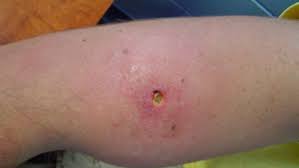
Cases of “flesh-eating” bacteria infections are climbing across the Southeast. North Carolina has tallied 59 Vibrio infections and one death this year, while Florida and Louisiana have recorded eight fatalities.
By Liz McLaughlin, WRAL climate change reporter
A man has spent more than a week in an Outer Banks hospital after a small cut on his leg turned into a Vibrio vulnificus infection. Doctors say the flesh-eating bacterium can destroy tissue and become deadly in fewer than 48 hours.
His ordeal underscores new figures from the N.C. Department of Health and Human Services: 59 Vibrio illnesses and one death statewide through July 31. That is the second-highest midsummer total in five years and comes before the traditional late-August peak.
WRAL WeatherCenter Forecast
Watch More
“Every water sample we collect along the coast now contains some kind of Vibrio. That wasn’t true two decades ago,” said Rachel Noble, a microbiologist at UNC-Chapel Hill’s Institute of Marine Sciences.
Why are the bacteria spreading?
Sea-surface temperatures off Cape Hatteras have held in the mid-80s this summer, roughly two degrees above the 30-year average. Warmer winters no longer knock the bacteria back, Noble said, so they rebound quickly when the heat returns. Heavy rain then dilutes salt levels in sounds and tidal creeks, while runoff feeds the microbes—“ideal growing conditions almost overnight,” she said.
Sea-surface temperatures near Cape Hatteras have hovered in the mid-80s this summer, roughly two degrees above the 30-year average. Noble said milder winters let low levels of the bacteria survive year-round, so they rebound quickly once the heat returns.
The microbe also prefers brackish water, the half-salt, half-fresh mix found in sounds and tidal creeks. Heavy downpours dilute salinity just enough while washing nutrients into the water, giving Vibrio what Noble calls “an overnight buffet.”
“If we get four inches of rain, those estuaries flip from low risk to high risk almost immediately,” she said.
Who is at risk?
- Seafood workers handle sharp shells, crab claws and warm water all day, raising the odds of a puncture wound that can become infected before it is washed or bandaged.
- Beachgoers with an open cut, fresh tattoo or razor nick can be exposed when wading or swimming.
- Raw seafood fans risk stomach illness, and in the case of V. vulnificus the bacteria can move from gut to bloodstream.
The Centers for Disease Control and Prevention says about 20 percent of V. vulnificus cases are fatal, often within 48 hours.
How to stay safe
Health officials advise keeping any break in the skin out of salt or brackish water, washing with soap and fresh water after time in the surf, treating cuts with hydrogen peroxide, cooking shellfish thoroughly, and seeking medical help quickly if a wound turns red, swollen or blistered within 24 hours of water exposure.
More cases likely
Louisiana and Florida have already logged 30 infections and eight deaths this summer. Noble said the Carolinas could see additional cases as late-season heat and tropical downpours arrive.
“Warmer water is the common thread,” she said. “If we want to keep enjoying our coast, we need to respect that new reality and take a few extra precautions.”